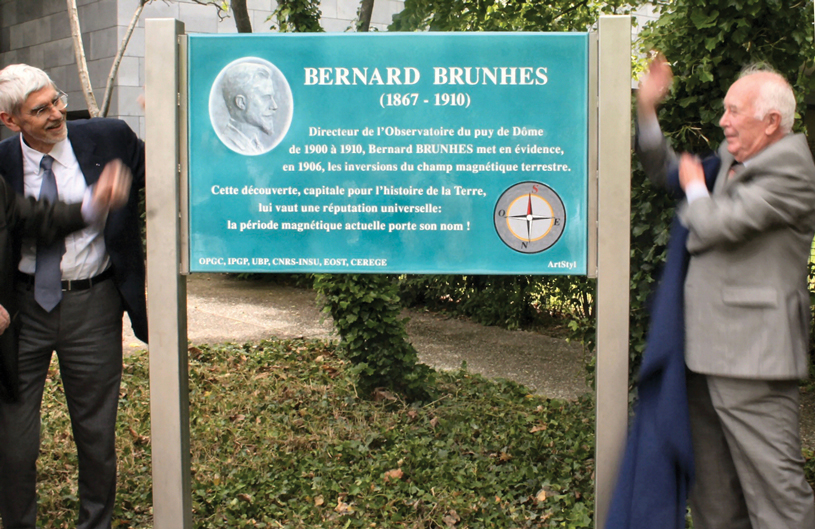In the early years of the 20th century, physicist Bernard Brunhes, then director of the Geophysical Observatory of Puy de Dôme (now Observatoire de Physique du Globe de Clermont), measured for the first time reverse magnetization in samples from a basaltic lava flow and from the underlying backed argillaceous sediments from the village of Pontfarein (now Pont Farin) in the Cantal volcanic district (Auvergne, France).
He correctly interpreted this observation as a consequence of the inversion of Earth’s magnetic field in the past [Brunhes, 1905a, 1905b and 1906]. Subsequent observations by Mercanton [1926 a and b] and Matuyama [1929] have reinforced this assumption. This paradigm of periodic magnetic reversals resulted in the construction of a paleomagnetic scale that has been of great consequence for the understanding of Earth’s dynamics.
Because of the importance of the discovery, Cox et al. [1963] gave the name Brunhes to the present-day normal magnetic epoch.
To commemorate the centenary of Brunhes’s discovery, a monument was erected near the entrance of the present-day observatory. The panel was unveiled on 4 June 2014 by Vincent Courtillot, a former student of Allan Cox, and Etienne Leflaive, the grandson of Bernard Brunhes.
References
Brunhes, B. (1905a), Sur la direction de l’aimantation permanente dans une argile de Pontfarein, C. R. Acad. Sci. Paris, 141, 567–568.
Brunhes, B. (1905b), L’inclinaison magnétique en Europe dans le passé et l’argile métamorphique de Pontfarein, commune de Cézens, Cantal, Rev. Haute Auvergne, 7, 398–405.
Brunhes, B. (1906), Recherches sur la direction de l’aimantation des roches volcaniques, J. Phys. Théor. Appl., 4ème série, 5, 705–724
Cox, A., R. R. Doell, and G. B. Dalrymple (1963), Geomagnetic polarity epochs and Pleistocene geochronometry, Nature, 198, 1049–1051.
Matuyama, M. (1929), On the direction of magnetization of basalt in Japan, Tyosen and Manchuria, Proc. Imp. Acad. (Tokyo), 5, 203–205.
Mercanton, P.-L. (1926 a), Aimantation de basaltes groenlandais. C. R. Acad. Sci. Paris, 182, 859–860
Mercanton, P.-L. (1926 b), Aimantation des roches volcaniques australiennes, C. R. Acad. Sci. Paris, 182, 1231–1232.
—Jacques Kornprobst and Jean-François Lénat, Laboratoire Magmas et Volcans, Observatoire de Physique du Globe de Clermont, Clermont-Ferrand, France, email: [email protected]
© 2014. American Geophysical Union. All rights reserved.
© 2014. American Geophysical Union. All rights reserved.

